#zine el arab
Explore tagged Tumblr posts
Text
Last week, Tunisia’s president, Kais Saied, made his first trip to China and signed a strategic partnership with President Xi Jinping. The week prior, Saied made headlines for becoming the first Tunisian president to visit Iran since the Islamic Revolution. And before that, rumors swirled about Russian planes landing in Djerba.
It is too early to tell whether any of these events mark a major, strategic realignment of Tunisia away from its traditional allies in the West. More likely, Saied is playing global and regional powers against one other to secure the best deal, an art form perfected by other leaders in the region.
But Saied has made one major shift to Tunisia’s foreign policy that in turn might help explain his recent outreach to Iran, China, and Russia. Over the past year, Saied has overseen a sea change in Tunisia’s position on the two-state solution for Israelis and the Palestinians. While Tunisia had historically been an outlier in the region for being one of the first to accept a two-state solution, today it is increasingly becoming an outlier for rejecting it.
While popular at home, this shift has strained Tunisia’s relations with both the West and the Arab Gulf states. It is in this context of greater isolation internationally that Saied now dangles the threat of relations with Iran, China, and Russia.
The first to endorse two states
Tunisia’s founding father, Habib Bourguiba (r. 1956-1987), was one of the first Arab leaders to advocate, albeit cautiously, for negotiations with Israel. While other states in the region were gearing up for war, President Bourguiba in 1965 gave a major speech in Jericho urging Palestinians and Arabs to give up their “all or nothing” strategy, and then told Le Monde that they should accept the United Nations partition plan.
At the United States’ request, Tunisia would later host the Palestinian Liberation Organization (PLO), and despite being bombed by Israel in 1985, Bourguiba remained supportive of dialogue until his last days in office. His successor, Zine El Abidine Ben Ali (r. 1987-2011), continued his policies, facilitating talks between the PLO and Israeli officials in Tunis that would then evolve into the Oslo peace process. Although those talks faltered and the second intifada erupted, Ben Ali would sign on to the Arab Peace Initiative (API), advocating a two-state solution. Tunisia’s support for that proposition would survive the 2011 revolution, with Tunisia hosting an Arab League summit in March 2019 that renewed the region’s commitment to the API. For almost 60 years, Tunisia at least paid lip service to the notion of a two-state solution.
The first to abandon it
Saied (r. 2019-) has now initiated a major shift to that long-standing advocacy of two states. In his electoral campaign in 2019, Saied argued that any normalization with Israel was akin to high treason, receiving thunderous applause at a presidential debate. While Saied was initially constrained by Tunisia’s semi-presidential system, his power grab in 2021 and subsequent consolidation of control has allowed him to gradually shift Tunisia’s foreign policy.
At first, the shift was subtle. Saied’s new 2022 constitution went further than previous ones by calling not just for the liberation of Palestine but a Palestinian state with Jerusalem (and not just East Jerusalem) as its capital. In August 2023, Saied rejected rumors he might normalize with Israel, saying Palestinians should instead regain their rights over “all of Palestine.”
But Hamas’s attacks on October 7 and the war thereafter have accelerated Saied’s break with Tunisia’s more moderate tradition. On the night of October 7, Saied described the attacks as “legitimate resistance,” saying that “what some media were referring to as the Gaza envelope is Palestinian land that has been under Zionist occupation for decades,” and that therefore “the Palestinian people have the right to recover it and to recover all of the land of Palestine.” In a video published on his Facebook page, Saied re-emphasized “all” of the land.
What had previously been the president’s personal rhetoric then became official policy. On October 11, the Arab League put out a joint statement condemning the killing of civilians by both sides and pledging support for a two-state solution along the June 4, 1967 borders. But Saied had Tunisia put in a reservation, noting instead “the right of the Palestinian people to establish their independent state on all of the land of Palestine.” Tunisia would continue that pattern over the next few months, routinely issuing reservations to joint statements produced at Arab League and the Organization of Islamic Cooperation (OIC) summits, becoming an outlier at these meetings.
In May, these reservations grew increasingly explicit. At the OIC summit in Banjul and then the Arab League summit in Manama, Tunisia expressed its reservations specifically about the use of the terms “June 4, 1967 borders,” “two-state solution,” and “East al-Quds,” emphasizing instead its support for an “independent state on the entire territory of Palestine with Al-Quds Al-Sharif as its capital.” For all intents and purposes, Tunisia abandoned its long-standing official position supporting a two-state solution.
Consequences of the shift
This shift in Tunisian foreign policy has played well at home, earning praise from Tunisians on social media and even from the Nobel Peace Prize-winning Tunisian General Labor Union. In part because of their history of hosting the PLO—and being bombed for it—Tunisians express some of the strongest support for Palestine in public opinion polls. The Arab Barometer, for instance, found that only 9% of Tunisians said it was good for the region that countries have started working with Israel, compared to 19% of Iraqis and Lebanese, 23% of Egyptians, and 32% of Sudanese. This pro-Palestinian sentiment in Tunisia has only grown in the wake of October 7, with the Arab Barometer finding support for normalization with Israel falling from 12% to 1%, and open calls for armed resistance growing from 6% to 36%.
But although Saied’s rhetoric on Israel has garnered him popularity at home, it has also left him even more isolated internationally. He had already complicated Tunisia’s relations with the United States through his coup and continued rejection of what he calls foreign interference. This was simply another nail in the coffin. By November, U.S. State Department officials were telling me they were highly concerned that Saied had become “an outlier in the region,” no longer supportive of a two-state solution. They feared that his “radical rhetoric against Israel” might contribute to extremism, recalling that Tunisia sent the largest per capita contingent of fighters to the Islamic State.
Saied’s positions have also complicated his relations with the Arab Gulf states, who have pursued normalization or are on track to do so. Many had expected Saudi Arabia and the United Arab Emirates to openly and financially support Saied’s takeover much like they did Egypt’s Abdel Fattah el-Sisi. But they have instead been more hesitant, preferring investment over aid and loans, and allegedly insisting on normalization, or at least toning down Saied’s criticism of it.
Managing isolation
This has left Saied with few strong allies, primarily Algeria and Italy. It is in this context of isolation that we should view Saied’s recent outreach to Iran, China, and Russia. On the one hand, these countries more naturally fit with Saied’s worldview, both on the Palestinian issue as well as on his broader critique of Western imperialism. Saied’s meeting with Iranian Supreme Leader Ali Khamenei, for instance, reportedly centered around Palestine, with Khamenei praising Saied’s “anti-Zionist stance” and emphasizing the need to develop more such stances in the Arab world, and Saied agreeing, saying “the Islamic world must exit its current passive position.”
At the same time, Saied has thus far been careful not to push too far and elicit a rupture with Tunisia’s traditional allies. In November, for instance, Saied quashed a bill in parliament that would have criminalized normalization with Israel, on account of it endangering Tunisia’s external interests, presumably with the West and the Arab Gulf states. Indeed, a full realignment or clean break with the West is near impossible, given the strong links Tunisia’s military has with the United States and its economy has with Europe. A more likely scenario is an attempt to balance between these global and regional powers, securing what it can from each.
Still, whether or not relations with Iran, China, or Russia develop further, it is clear that Saied has already initiated a sea change in one aspect of Tunisia’s foreign policy, departing from its decades-long endorsement of a two-state solution.
9 notes
·
View notes
Text

"Based on a wealth of new primary data, this book offers the first account of the internal regime factors that ultimately caused the fall of Zine el-Abidine Ben Ali's long dictatorship in Tunisia during the Arab Uprisings. Anne Wolf's account challenges studies that focus on the role of mass mobilization alone, and demonstrates that in the last decade of Ben Ali's presidency, dissent within his ruling party - the Constitutional Democratic Rally - mounted to such an extent that followers began challenging their own powerbroker. The culmination of this was a secret coup d'état staged by regime figures against Ben Ali in January 2011, an event that has not previously been uncovered."
3 notes
·
View notes
Text
Revolution in Tunisia 14 years later: 'The emperor has no clothes' | arab spring
14 years ago, on January 14, 2011, Tunisians filled Boulevard Habiba Bourguiba, a central thoroughfare in Tunisia, with cries of freedom and dignity as they celebrated the overthrow of dictator Zine El Abidine Ben Ali. He fled the country and announced his resignation after 28 days of relentless civil disobedience marked by “occupations” of public squares in almost every city in the country,…
0 notes
Text
Tunisia's 14-year revolution: 'The Emperor has no clothes' | Arab Spring
Fourteen years ago, on January 14, 2011, Tunisians filled Habib Bourguiba Boulevard, central Tunis, with cries of freedom and honor as they celebrated the ouster of dictator Zine El Abidine Ben Ali. He fled the country and announced his resignation after 28 days of incessant violence that was demonstrated by public “activities” in almost every city of the country, due to the deadly suicide of the…
0 notes
Text
Tunisia's 14-year revolution: 'The Emperor has no clothes' | Arab Spring
Fourteen years ago, on January 14, 2011, Tunisians filled Habib Bourguiba Boulevard, central Tunis, with cries of freedom and honor as they celebrated the ouster of dictator Zine El Abidine Ben Ali. He fled the country and announced his resignation after 28 days of incessant violence that was demonstrated by public “activities” in almost every city of the country, due to the deadly suicide of the…
0 notes
Text
Tunisia's 14-year revolution: 'The Emperor has no clothes' | Arab Spring
Fourteen years ago, on January 14, 2011, Tunisians filled Habib Bourguiba Boulevard, central Tunis, with cries of freedom and honor as they celebrated the ouster of dictator Zine El Abidine Ben Ali. He fled the country and announced his resignation after 28 days of incessant violence that was demonstrated by public “activities” in almost every city of the country, due to the deadly suicide of the…
0 notes
Text
Events 1.14
1236 – King Henry III of England marries Eleanor of Provence. 1301 – Andrew III of Hungary dies, ending the Árpád dynasty in Hungary. 1761 – The Third Battle of Panipat is fought in India between the Afghans under Ahmad Shah Durrani and the Marathas. 1784 – American Revolutionary War: Ratification Day, United States - Congress ratifies the Treaty of Paris with Great Britain. 1797 – The Battle of Rivoli is fought with a decisive French victory by Napoleon Bonaparte, marking the beginning of the end of the War of the First Coalition and the start of French hegemony over Italy for two decades. 1814 – Treaty of Kiel: Frederick VI of Denmark cedes the Kingdom of Norway to Charles XIII of Sweden in return for Pomerania. 1858 – Napoleon III of France escapes an assassination attempt made by Felice Orsini and his accomplices in Paris. 1899 – RMS Oceanic, the largest ship afloat since SS Great Eastern, is launched. 1900 – Giacomo Puccini's Tosca opens in Rome. 1907 – An earthquake in Kingston, Jamaica kills more than 1,000 people. 1911 – Roald Amundsen's South Pole expedition makes landfall on the eastern edge of the Ross Ice Shelf. 1939 – Norway claims Queen Maud Land in Antarctica. 1943 – World War II: Japan begins Operation Ke, the successful operation to evacuate its forces from Guadalcanal during the Guadalcanal Campaign. 1943 – World War II: Franklin D. Roosevelt and Winston Churchill begin the Casablanca Conference to discuss strategy and study the next phase of the war. 1951 – National Airlines Flight 83 crashes during landing at Philadelphia International Airport, killing seven passengers and crew. 1952 – NBC's long-running morning news program Today debuts, with host Dave Garroway. 1953 – Josip Broz Tito is elected the first President of Yugoslavia. 1954 – The Hudson Motor Car Company merges with Nash-Kelvinator Corporation forming the American Motors Corporation. 1957 – Kripalu Maharaj is named fifth Jagadguru (world teacher) after giving seven days of speeches before 500 Hindu scholars. 1960 – The Reserve Bank of Australia, the country's central bank and banknote issuing authority authorized by the 1959 Reserve Bank Act, is established. 1967 – Counterculture of the 1960s: The Human Be-In takes place in San Francisco, California's Golden Gate Park, launching the Summer of Love. 1969 – USS Enterprise fire: An accidental explosion aboard the USS Enterprise near Hawaii kills 28 people. 1972 – Queen Margrethe II of Denmark ascends the throne, the first Queen of Denmark since 1412 and the first Danish monarch not named Frederik or Christian since 1513. 1973 – Elvis Presley's concert Aloha from Hawaii is broadcast live via satellite, and sets the record as the most watched broadcast by an individual entertainer in television history. 1993 – Sinking of the MS Jan Heweliusz: In Poland's worst peacetime maritime disaster, ferry MS Jan Heweliusz sinks off the coast of Rügen, drowning 55 passengers and crew; nine crew-members are saved. 2004 – The national flag of the Republic of Georgia, the so-called "five cross flag", is restored to official use after a hiatus of some 500 years. 2010 – Yemen declares an open war against the terrorist group al-Qaeda. 2011 – President Zine El Abidine Ben Ali of Tunisia seeks refuge in Saudi Arabia after a series of demonstrations against his regime, considered to be the birth of the Arab Spring. 2016 – Multiple explosions reported near the Sarinah Building, Jakarta, followed by shootout between perpetrators and the police, killing seven people. The Islamic State of Iraq and the Levant claimed responsibility. 2019 – A Saha Airlines Boeing 707 crashes at Fath Air Base near Karaj in Alborz Province, Iran, killing 15 people. 2024 – Queen Margrethe II abdicates as Queen of Denmark and is succeeded by her son, Frederik X.
0 notes
Text

It was a question of dignity! I’m glad I didn’t stop to think, like the government! Such petty calculations didn’t interest me!
Albert Memmi.
This is a post about modern Tunisia; please see here, here, here, here, here, here and here for the ancient history, which stretches back thousands of years.
Sculpted by Hedi Selmi, the Martyrs' Monument in Sousse is in tribute to nine demonstrators who were killed in a clash with French soldiers in 1952, and to all those who fought for Tunisian independence.
Modern Tunisia began with the Ottoman Empire, who ruled here from 1574 to 1881, and the French Empire, which took over under the terms of the Treaty of Bardo in 1881 (Memmi's account in his book 'The Pillar of Salt', of being native African and Jewish under French rule, is an excellent way to understand what life was like for poor Tunisians of this era.
Almost immediately, this was resented, not only by North African Arabs, Berbers and Jews, but also by many of the non-French Europeans in Tunisia, who were mainly Maltese and Italians.
(From 1868 to 1881, Italy had most favoured nation status, and Italian nationalists thought they should be the European power which gained in North Africa from the Ottomans' ousting after losing the Russo-Turkish War of 1877-8; French actions were known by Italian nationalists as 'the slap of Tunis'!
In 1914, Tunisia was dragged into World War 1 along with its new French rulers, who were on the opposite side to the old Ottoman masters; this would have baffled most Tunisians, but it still left 10,462 Tunisian soldiers dead; in the early war years, Tunisians proved they could fill the jobs, professions and landowning of Europeans, but were unceremoniously shoved back after the war ended in 1918.
Therefore, in 1920, the Destour was founded, which had as its aim freeing Tunisia from French control, and as we shall see many later Tunisian leaders cut their teeth in its struggles.
In World War 2, France was conquered by the Nazis in 1940 and the German satrapy, the Vichy Republic, occupied Tunisia, therefore throughout 1942-43 Tunisia was a battleground between the Axisand the Allies (who gained the support of Tunisian and French Resistance defectors) and the Allies drove the Axis out on 20 April 1943.
(Memmi was himself kidnapped and enslaved by the Italians, before escaping to join the resistance, who refused to take him on because of his race), and after the allies this war in 1945, won France was embroiled in Vietnam and Algeria and took the bargain that the pro-western and pro-allied Tunisian leader Habib Bourguiba (who had been imprisoned by the Italians in 1943) offered them.
Tunisia became an independent state in 1956 with Bourguiba as Prime Minister and the next year Mohammed VIII was 'encouraged' to abdicate by Bourguiba (one difference between Tunisia and nearby Morocco, which I went to last year, is that Tunisia is a republic and Morocco is still a monarchy) and this brought to an end the Husaynid dynasty, which had reigned under Ottoman and French overlordship from 1705 . Bourguiba, who was from nearby Monastir (please see herefor more on him) became president in 1957.
Under his leadership, Tunisia became a modernising, secular, pro-Western country whose Personal Law Code of 1956 enshrined state education and women's rights (to this day, while hijab has never been banned in Tunisia, only a minority in Sousse were wearing it), and led to Bourguiba being compared to the Turkish leader Mustafa Kemal Ataturk, though there was not political freedom, and as his reign went on and on he became more unpopular.
Soon after the bombings in Monastir and Sousse (where I stayed) of 1987, in which 13 were blown up and injured by Islamists, Bourguiba was overthrown by Zine El Abidine Ben Ali, who in fact came from Sousse.
Ben Ali belonged to Bourguiba's policy (variously called Destour, Neo-Destour, Socialist Destour and Constitutional Democratic Rally) and followed largely the same agenda and also ruled seemingly unchallenged.
Ben Ali was himself overthrown in 2011, after the Arab Spring, which began here when 26 year old street vendor Mohammed Bouazizi, unable to make a living in Ben Ali’s bureaucracy, set himself on fire in 2010.
(The same decade, beginning with the illegal invasion of Iraq in 2003, brought down such Arab strongmen as Saddam Hussein of Iraq, Hosni Mubarak of Egypt, and Tunisia'a neighbour, Colonel Gaddafi of Libya).
Then, with Fouad Mebazaa as acting president for nine months, the first free and fair elections to the parliament were held in 2011 and the biggest party was the Islamist Ennahda (which Ben Ali abolished in 1989 but which came back after his downfall.
The next acting president Moncef Marzouki, himself secular, governed with Ennahda, before losing the 2014 election to Beji Caid Essebi, a veteran of Destour, who died in office in 2019 (Ben Ali, who had fled to Saudi Arabia after being overthrown, died there in the same year).
In that year, after 91 days with Mohamed Ennaceur as acting president, Kais Saied won the election, dissolved parliament in 2021, then 'won’ a constitutional referendum in 2022 with 94% of the vote, which he followed with 'victory’ in the 2024 presidential election with 91% of the vote. (He also 'earned’ a majority in parliament after opposition parties boycotted the 2022 election, then imprisoned Marzouki).
(This process is ongoing as Syria's dictator, Bashar al Assad, was overthrown in 2024 by his own people, a fact lamented by our tour guide who had been one of his supporters! Nevertheless, what happened there would not have happened without what happened here).
In the end though I think Bourguiba succeeded in his aims: We cannot forget that we are Arabs, that we are rooted in the Islamic civilization, as much as we cannot neglect the fact of living in the second part of the 20th century. We want to take part in the march of civilization and take a place deep into our time.
0 notes
Text
After a fierce crackdown, Tunisia's president likely to be re-elected on Sunday
With his major opponents imprisoned or left off the ballot, Tunisian President Kais Saied faces few obstacles to winning re-election on Sunday, five years after riding anti-establishment backlash to a first term. The North African country’s Oct. 6 presidential election is its third since protests led to the 2011 ouster of President Zine El Abidine Ben Ali — the first autocrat toppled in the Arab…
0 notes
Text
A visitor to Tunis is immediately taken in by the city's graffiti-covered walls, adorned with colourful sketches and slogans in French, English and Arabic.
The country's graffiti scene has evolved and flourished since the political uprising in 2011, which led to the fall of Tunisia's long-standing dictator, Zine El Abidine Ben Ali, and brought in a new political and cultural era.
The political slogans on the walls became more outspoken, and artists took on new daring projects.
While there has always been graffiti in Tunisia, many of the bolder and bigger paintings emerged after 2011.
Despite graffiti being illegal under Tunisian law, it seems authorities have allowed various artworks to remain up across the country, with some becoming fixtures of Tunisia's urban landscape.
On Djerba island, authorities allowed a youth project to turn a part of the old neighbourhood of Houmt Souk into a walk-through gallery of graffiti by local artists.
The project, now called Djerba Hood, has become a popular tourist attraction.
Graffiti’s reputation as a simple act of vandalism started changing and people’s views shifted in support of the messages it carries and the colour and life it can bring to otherwise dull architecture.
Sociologist and street art specialist Eya Ben Mansour says Tunisians have always used the walls of the public space as a canvas for their thoughts.
“We find the first roots in the nineties with writings on prisons’ walls,” Ms Ben Mansour told The National.
1 note
·
View note
Text
Country of the Month: Tunisia
Welcome to the country of November 2023: Tunisia! This month, we'll be exploring different Tunisian recipes and dishes all while working on our skill of cooking. To kick it off, I thought it would be a great idea to share some fun facts about this wonderful country:

Diverse Geography: Tunisia boasts a diverse landscape, from the golden beaches of the Mediterranean coast to the vast Sahara Desert in the south.
Ancient Carthage: The ancient city of Carthage, located in present-day Tunisia, was a powerful and influential civilization that rivaled Rome in antiquity. It was famously destroyed in the Punic Wars.
UNESCO Sites: Tunisia is home to eight UNESCO World Heritage Sites, including the historic medina of Tunis, the archaeological site of Dougga, and the Medina of Sousse.
Star Wars Filming Location: The deserts of Tunisia, particularly Matmata and Tataouine, were used as filming locations for the original Star Wars trilogy, where iconic scenes on the planet Tatooine were shot.
Olive Oil Production: Tunisia is one of the world's largest producers of olive oil, and olive cultivation has been a part of its culture for thousands of years.
Arab Spring: The Tunisian Revolution in 2010-2011, also known as the Arab Spring, began in Tunisia and led to the ousting of President Zine El Abidine Ben Ali, sparking similar movements across the Arab world.
Diverse Culture: Tunisia is a melting pot of cultures, with influences from Arab, Berber, Phoenician, Roman, and French civilizations, creating a rich and unique cultural tapestry.
Medina of Tunis: The historic medina of Tunis is one of the best-preserved medieval cities in the Arab world, with narrow winding streets, bustling souks, and stunning architecture.
Roman Ruins: Tunisia is home to some remarkable Roman archaeological sites, including the ancient city of Dougga, often referred to as the "best-preserved Roman small town in North Africa."
Djerba Island: Djerba, an island off the coast of Tunisia, is known for its beautiful beaches, ancient synagogues, and as the legendary home of the lotus-eaters in Greek mythology.
As we embark on this culinary journey through the flavors of Tunisia for the month of November 2023, we've opened a tantalizing gateway to a world of spices, history, and vibrant traditions. With each dish we prepare, we'll be weaving a tapestry of flavors that tell the story of this North African gem. From the bustling markets of Tunis to the sun-soaked shores of Djerba, our kitchens will become a portal to Tunisia's rich cultural heritage. As we savor each bite and delve into the tales of this fascinating country, let us remember that through food, we can travel the world, connect with diverse cultures, and share in the joys of discovery. So, gather your ingredients, don your apron, and join me in celebrating the vibrant tastes of Tunisia this November. Bon appétit!
0 notes
Photo
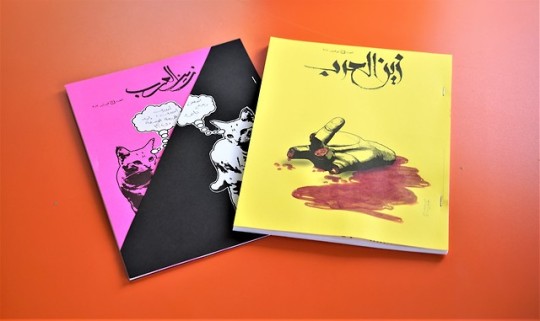
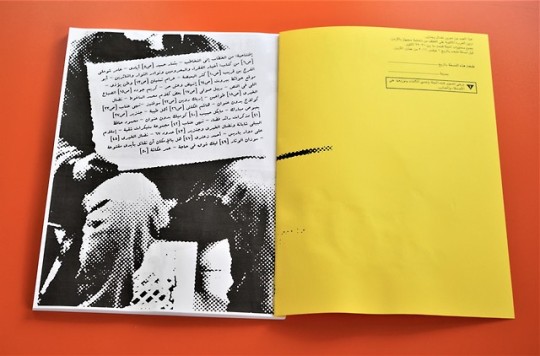
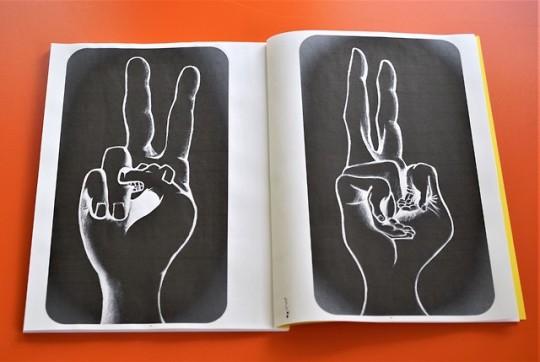
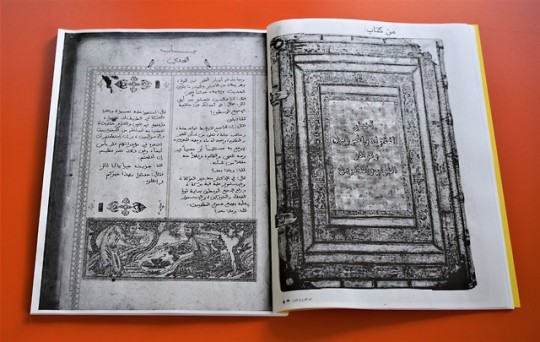
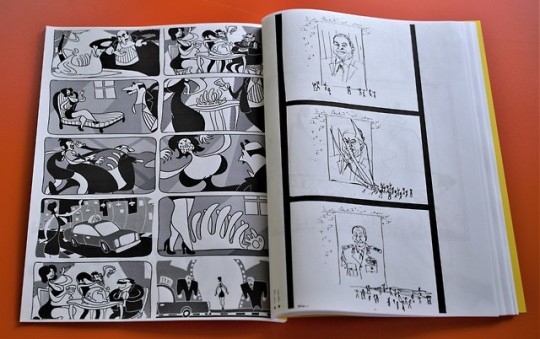
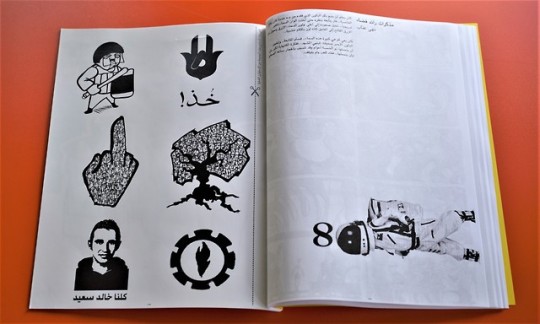
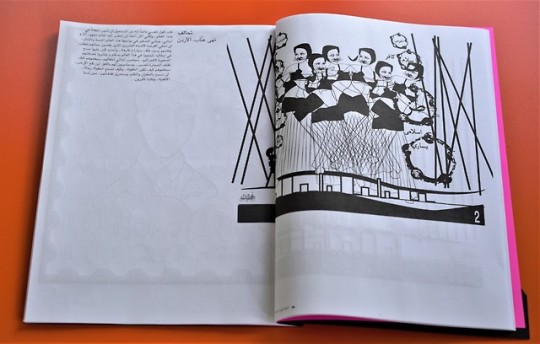
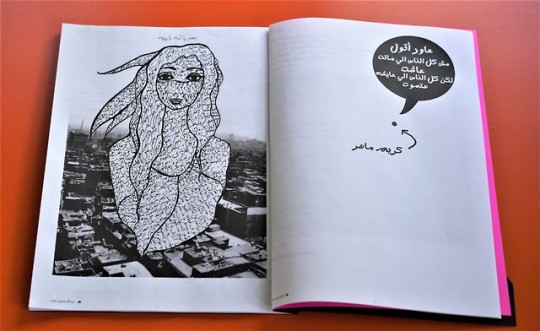
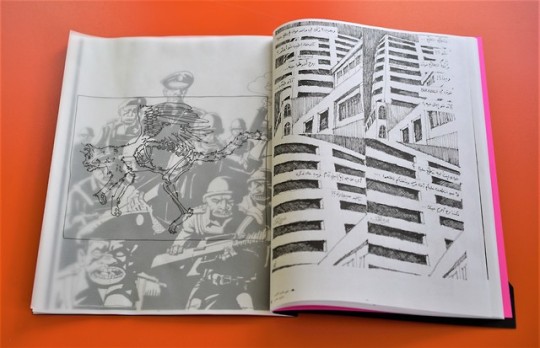
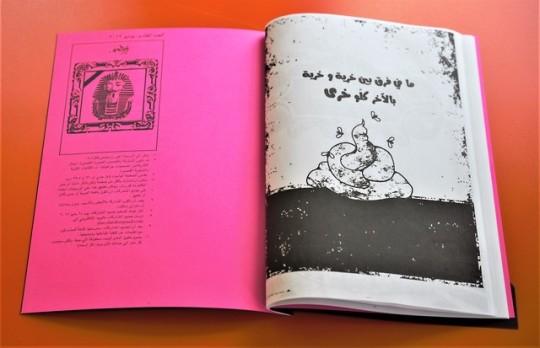
ZINE EL-ARAB is a zine I launched and co-edited with Nidhal Alkhairy. Only two issues were ever produced, the first in late 2011 and the second in early 2012.
A couple copies have recently (August 2019) made their way to the collections of the Bavarian State Library and Archive Artist Publications, both located in Munich, so I thought it might be a good time to revisit how the zine came about and why it was discontinued.
If you know me at all, then you know I like to operate where I see vacuums in the culture. Zine El-Arab came about precisely for that reason. This was 2011, a time of great revolutionary upheaval that started in Tunisia, spilled over into Egypt, and kind of spread from there not just in the region but halfway across the world.
By late 2011, there was really no denying the ripples of change pulsating through Cairo. It was evident on the streets, in music, conversations, at art galleries, on television, it was everywhere. But I was growing frustrated that there didn’t seem to be any regular publication that featured the voices of dissent that were otherwise all around you. It felt like there was a rift between everyday voices and what was being published, and how cool would it be if there were at least one? Especially if it were a crude one.
The big kicker though was a residency that was offered to me by Makan in Amman (Jordan) where I got to meet Nizar Alkhairy and engaged with many other members of the local art/poetry/architecture/journalism scene, and that’s when I felt having a singular venue that can act as a vessel for all these voices from across multiple borders would not only be a good idea, but quite possibly a necessary one. Not just for the voices from Jordan or Egypt but across the entire Arab-speaking world if possible. And thus came Zine El-Arab, admittedly hyperbolically touted as the first pan-Arab zine. The vast majority of participants were from Jordan and Egypt, but it also received material from Palestine, Lebanon, Syria, and Qatar (I imagine its reach could have extended even further had it continued).
The formula was seemingly quite simple. The cover image (created by me) was posted on social media, inviting contributors from the Arab-speaking world to respond to it with either text or image (B&W only). Appropriate submissions would be selected and assembled into a digital zine which would be uploaded as a PDF with detailed instructions about printing and assembly. The idea was to decentralize not only the content, but the physical production of the zine as well, whereby contributors and readers could print their own copies and organically disseminate among their communities.
In reality, both issues had their “launch parties”, issue one at Makan in Jordan and issue two at the Townhouse Gallery in Cairo, which involved needing to print and assemble something like 100 copies for each launch.
One thing I wanted to do was to take advantage of the fact that each copy was technically individually printed and bound. So for issue #1 for example, there were instructions to paint the blood stain on the cover manually, and inside there was one page (adorned with multiple images) intended for print on adhesive-paper, whereby readers could cut out and use as stickers.
Issue #2′s cover — themed around racism and discrimination — was even more elaborate, comprised of essentially two covers with the first manually cut at a diagonal angle. The dialogue balloons were cut out and manually glued on, left blank to allow readers to write the text they wanted (with the original prompt acting as a thematic guide). And inside the issue there was one page printed on translucent paper, creating a kind-of-combined image with the page that comes right after (although, for the editions sent out to the Bavarian State Library and AAP, I had to illustrate that particular page by hand because the translucent paper kept jamming inside my printer!)
Although these very handmade aspects gave the zines a unique tactile quality, they become exhausting and impractical if you have to manually apply them to 100+ copies.
In the end, the zines were a fun experiment that without a doubt very much encapsulated the air of the time, and provided for a formidable venue for a selection of writers, artists, illustrators, and graphic designers to voice their thoughts.
It should be noted that there’s a little wordplay in the zine’s name. The word “zine” when written in Arabic is the same exact spelling as the word “zain”, roughly meaning “the best”. So Zine El-Arab not only suggests “the zine of the Arab” but it is simultaneously read as “the best of the Arab”.
Special thanks to Hussein Alazaat for the masthead calligraphy on both covers. And thanks to all the badass contributors on both issues: Bashar Humeidh, Amer Shumali, Abu Alfarag Bin Qareeb, Aram Tamenian, Kareem Gouda, Rebel Souly, Noha Ennab, Hashem Elkelesh, Michael Habib, Mahmoud Hafez, Islam Shabana, Ahmed Zaatari, Suzan Alwattar, Omar Okasha, Ahmed T.,Nancy Ibrahim, Damon Kowarsky, Mohammed Abdel Hady, Zeina Azouqa, Omnia Naguib, Saman S., Jacqueline George, Elkamouny, Batta Souda, and of course, Nidal Alkhairy.
And last but not least big thanks to Makan in Amman and the Townhouse Gallery in Cairo.
For PDF downloads: Zine El Arab #1 Zine El Arab #2
-- Ganzeer August 9, 2019 Houston, TX
11 notes
·
View notes
Photo
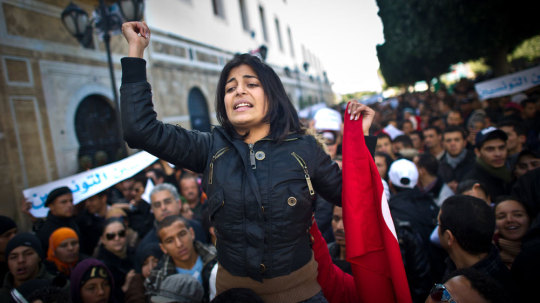
On this day, 18 December 2010, following the self-immolation of street vendor Mohamed Bouazizi, protesters took to the streets in Tunisia. The protests ballooned into a far-reaching social movement which eventually achieved the overthrow of the dictator Zine El Abidine Ben Ali. It also sparked a wave of uprisings across the Middle East and North Africa, which became known as the Arab Spring. https://www.facebook.com/workingclasshistory/photos/a.296224173896073/2164195910432214/?type=3
170 notes
·
View notes
Text
Events 1.14
1236 – King Henry III of England marries Eleanor of Provence. 1301 – Andrew III of Hungary dies, ending the Árpád dynasty in Hungary. 1639 – The "Fundamental Orders", the first written constitution that created a government, is adopted in Connecticut. 1761 – The Third Battle of Panipat is fought in India between the Afghans under Ahmad Shah Durrani and the Marathas. 1784 – American Revolutionary War: Ratification Day, United States - Congress ratifies the Treaty of Paris with Great Britain. 1814 – Treaty of Kiel: Frederick VI of Denmark cedes the Kingdom of Norway to Charles XIII of Sweden in return for Pomerania. 1858 – Napoleon III of France escapes an assassination attempt made by Felice Orsini and his accomplices in Paris. 1899 – RMS Oceanic (1899) is launched. She is the largest ship afloat since Brunel's SS Great Eastern. 1900 – Giacomo Puccini's Tosca opens in Rome. 1907 – An earthquake in Kingston, Jamaica kills more than 1,000 people. 1911 – Roald Amundsen's South Pole expedition makes landfall on the eastern edge of the Ross Ice Shelf. 1939 – Norway claims Queen Maud Land in Antarctica. 1943 – World War II: Japan begins Operation Ke, the successful operation to evacuate its forces from Guadalcanal during the Guadalcanal Campaign. 1943 – World War II: Franklin D. Roosevelt and Winston Churchill begin the Casablanca Conference to discuss strategy and study the next phase of the war. 1951 – National Airlines Flight 83 crashes during landing at Philadelphia International Airport, killing seven passengers and crew. 1952 – NBC's long-running morning news program Today debuts, with host Dave Garroway. 1953 – Josip Broz Tito is elected the first President of Yugoslavia. 1954 – The Hudson Motor Car Company merges with Nash-Kelvinator Corporation forming the American Motors Corporation. 1957 – Kripalu Maharaj is named fifth Jagadguru (world teacher) after giving seven days of speeches before 500 Hindu scholars. 1960 – The Reserve Bank of Australia, the country's central bank and banknote issuing authority authorized by the 1959 Reserve Bank Act, is established. 1967 – Counterculture of the 1960s: The Human Be-In takes place in San Francisco, California's Golden Gate Park, launching the Summer of Love. 1969 – USS Enterprise fire: An accidental explosion aboard the USS Enterprise near Hawaii kills 28 people. 1972 – Queen Margrethe II of Denmark ascends the throne, the first Queen of Denmark since 1412 and the first Danish monarch not named Frederik or Christian since 1513. 1973 – Elvis Presley's concert Aloha from Hawaii is broadcast live via satellite, and sets the record as the most watched broadcast by an individual entertainer in television history. 1993 – In Poland's worst peacetime maritime disaster, ferry MS Jan Heweliusz sinks off the coast of Rügen, drowning 55 passengers and crew; nine crew-members are saved. 2004 – The national flag of the Republic of Georgia, the so-called "five cross flag", is restored to official use after a hiatus of some 500 years. 2010 – Yemen declares an open war against the terrorist group al-Qaeda. 2011 – President Zine El Abidine Ben Ali of Tunisia seeks refuge in Saudi Arabia after a series of demonstrations against his regime, considered to be the birth of the Arab Spring. 2019 – A Saha Airlines Boeing 707 crashes at Fath Air Base near Karaj in Alborz Province, Iran, killing 15 people.
0 notes
Text








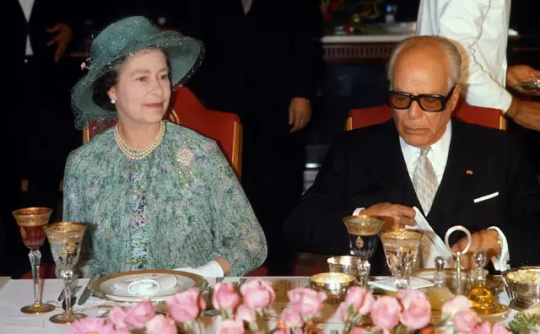

To open windows on other cultures, particularly Western culture, in order to come to grips with reality. In this way, our country can remain faithful to its cultural past while forging the instruments required for its future.
Habib Bourguiba.
Part of my Tunisia series; please see here, here, here, here, here, here and here for more (This is mostly a post about modern Tunisia, and other posts will have more about ancient times).
Tunisia has a long and storied history and has been conquered and/or settled by Berbers, Phoenicians, Romans, Carthaginians, Vandals, Byzantines, Jews, Arab Muslims (who gave Tunisia the Arabic language and Islamic religion, which have been followed by the majority ever since) Normans, Spaniards, Maltese, Italians, and Frenchmen, all of which produced Tunisians.
Modern Tunisia in effect begins with the Ottomans, who ruled here from 1574 until Tunisia became a French 'protectorate' with the Bardo Treaty of 1881.
Monastir's famous son, Habib Bourguiba, was born here in 1903; he had a western education at French schools (then uncommon in Tunisia) and the Sorbonne, and his first wife, Mathilde, was French. He joined the resistance against French rule, Dustour.
Tunisia was occupied by the Axis in 1942 after the Fall of France and the formation of the Vichy regime, which moved Bourguiba to Italy, in effect imprisoning him. In 1942 and 1943 Tunisia was a battleground before the Allies, supported by French and Tunisian troops who had defected to them, won this battle on 6 May 1943; Bourguiba, who had been moved to Tunis by his captors, was freed on 23 June.
After the war, the French power showed less interest in keeping Tunisia, especially since Bourguiba had supported the allies and was reliably pro-western, and French battles in neighbouring Algeria also weighed France down, so Bourguiba became Prime Minister of an independent state in 1956.
The Personal Status Code of 1956, and the deposition of Muhammad VIII in 1957 (upon which Bourguiba became president in 1957) was part of his strategy, enshrining women's rights and state education but not political freedom.
The aim was to build a secular state without what was seen as the backwardness of Islamic dress, though this was never abolished (In Monastir I saw hijab worn by only a minority, though it may be more widespread in more conservative rural areas).
Bourguiba ordered his own tomb to be built, from 1963-78, and this is where the shoot was taken. (In 9 he can be seen with our late queen Elizabeth II in 1980, and he met dozens of other world leaders, as you can see if you go to the rooms).
Bourguiba also, in 1982, invited the Palestinan Liberation Organisation here, where they stayed until 1991, and Tunisia again broke off relations with Israel after the Second Intifada of 2000, though this is not aimed at local Jews who have lived here uninterruptedly since the destruction of the Temple of Jerusalem in AD70, albeit fewer than in 1948.
Soon after the bombings in Monastir and Sousse (where I stayed) of 1987, in which 13 were blown up and injured by Islamists, Bourguiba was overthrown by Zine El Abidine Ben Ali, also a Destour veteran, who followed largely the same agenda and also ruled seemingly unchallenged.
Ben Ali was himself overthrown in 2011, after the Arab Spring, which began here when 26 year old street vendor Mohammed Bouazizi, unable to make a living in Ben Ali's bureaucracy, set himself on fire in 2010; this sparked protests among Tunisians who were already angry about the savage repression of the Gafsa miners' strike of 2008.
This being the beginning of the social media age, protestors could arrange online to meet one another and share stories of the looting of Ben Ali and his even more unpopular wife, Leila Trabelsi, and people outside Tunisia could more easily keep up with them than at other times of unrest in the Arab world.
The same decade, beginning with the illegal invasion of Iraq in 2003, brought down such Arab strongmen as Saddam Hussein of Iraq, Hosni Mubarak of Egypt, and Tunisia'a neighbour, Colonel Gaddafi of Libya. Tunisia has a lot in common with Morocco, where I went last year; one of the biggest differences is that Morocco kept its monarchy and its government was never overthrown.
Then, with Fouad Mebazaa as acting president for nine months, the first free and fair elections to the parliament were held in 2011 and the biggest party was the Islamist Ennahda (which Ben Ali abolished in 1989 but which came back after his downfall.
The next acting president Moncef Marzouki, himself secular, governed with Ennahda, before losing the 2014 election to Beji Caid Essebi, a veteran of Dustour, who died in office in 2019 (Ben Ali, who had fled to Saudi Arabia after being overthrown, died there in the same year).
In that year, after 91 days with Mohamed Ennaceur as acting president, Kais Saied won the election, dissolved parliament in 2021, then 'won' a constitutional referendum in 2022 with 94% of the vote, which he followed with 'victory' in the 2024 presidential election with 91% of the vote. (He also 'earned' a majority in parliament after opposition parties boycotted the 2022 election, then imprisoned Marzouki).
(The slide into authoritarianism is not obvious to tourists and I only learned about it when I read about it; there were no Iranian-style posters of Saied glowering down on us, but his presence is felt by all Tunisians).
At first it seemed Arab exceptionalism had been disproven and democracy could take root, but this did not happen in Tunisia as Saied played on fear of immigrants to keep himself in power.
Nevertheless, in this place, I was reminded that Bourgouiba, who lived until 2000, did what the historian Kenneth Perkins said, ‘the most innovative legal reform in the Muslim world since the abolition of sharia in Turkey in the 1920s’.
0 notes
Photo

Results of Arab Spring.
The Arab Spring was a series of anti-government protests, uprisings, and armed rebellions that spread across much of the Arab world in the early 2010s. It began in response to corruption and economic stagnation and was first started in Tunisia. From Tunisia, the protests then spread to five other countries: Libya, Egypt, Yemen, Syria, and Bahrain, where either the ruler was deposed (Zine El Abidine Ben Ali, Muammar Gaddafi, Hosni Mubarak, and Ali Abdullah Saleh) or major uprisings and social violence occurred including riots, civil wars, or insurgencies. Sustained street demonstrations took place in Morocco, Iraq, Algeria, Iranian Khuzestan, Lebanon, Jordan, Kuwait, Oman, and Sudan. Minor protests took place in Djibouti, Mauritania, Palestine, Saudi Arabia, and the Moroccan-occupied Western Sahara.
145 notes
·
View notes